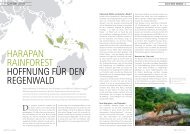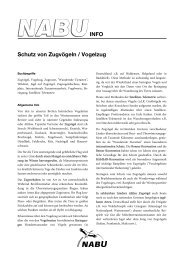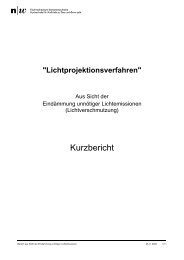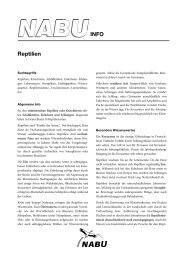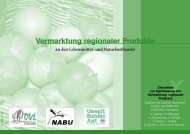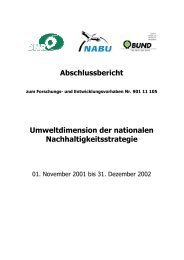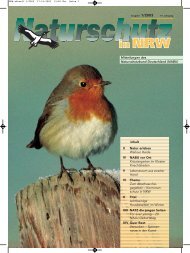Studie "The GMO-emperor has no clothes" (engl.) - Nabu
Studie "The GMO-emperor has no clothes" (engl.) - Nabu
Studie "The GMO-emperor has no clothes" (engl.) - Nabu
Create successful ePaper yourself
Turn your PDF publications into a flip-book with our unique Google optimized e-Paper software.
<strong>The</strong> “revolving door” syndrome in which<br />
industry staff are hired for government posts is<br />
standard practice in Australia and <strong>has</strong>, predictably,<br />
resulted in legislation and policies that promote<br />
GM tech<strong>no</strong>logies. <strong>The</strong> symbiotic relationship<br />
between the Australian government and the<br />
biotech industry is further evidenced by the fact<br />
that, by 2010, Monsanto owned major shares<br />
in public-owned agricultural enterprises. State<br />
government departments also develop GM crops<br />
under contracts with biotech corporations.<br />
Scientists in Australia are discouraged from airing<br />
concerns about <strong>GMO</strong>s in a few different ways.<br />
First, biotech companies simply refuse to allow<br />
analysis of their patented products. Second, several<br />
scientists have been dismissed from their posts<br />
after conducting research that questions the safety<br />
of <strong>GMO</strong>s.<br />
<strong>The</strong>re is limited labeling of foods containing<br />
<strong>GMO</strong>s. All GM vegetable oils, starches, and<br />
sugars, as well as eggs, meat and milk from animals<br />
fed with GM grains are exempt from any labeling.<br />
State governments are responsible for labeling<br />
standards; this greatly dilutes monitoring, testing,<br />
or enforcement of GM labeling.<br />
India<br />
In 1998, Monsanto with its Indian partner<br />
Mahyco, started illegal GM field trials in India,<br />
without approval of Genetic Engineering<br />
Approval Committee (GEAC), the statutory<br />
body for approving the release of <strong>GMO</strong>s into the<br />
environment.<br />
Monsanto <strong>no</strong>w controls 95 percent of the cotton<br />
seed market. It controls 60 Indian seed companies<br />
through licensing arrangements. It <strong>has</strong> pushed the<br />
price of seed from Rs. 7/kg to Rs. 3600/kg. Nearly<br />
half of this pricing reflects royalty payments.<br />
<strong>The</strong> tech<strong>no</strong>logy of engineering Bt genes into<br />
cotton was aimed primarily at controlling pests.<br />
However, new pests have emerged in Btcotton,<br />
leading to higher use of pesticides. In Vidharbha<br />
region of Maharashtra, which <strong>has</strong> the highest rate<br />
of farmer suicides, the area under Btcotton <strong>has</strong><br />
increased from 0.2 million hectares in 2004 to<br />
2.88 million hectares in 2007. Costs of pesticides<br />
for farmers <strong>has</strong> increased from Rs. 921 million<br />
to Rs. 13,264 billion in the same period, which is<br />
a 13-fold increase. Seed cost for cotton jumped<br />
from Rs. 7 to Rs. 3500 per kg. when Bt cotton was<br />
introduced.<br />
In spite of Indian studies showing losses to farmers<br />
and in spite of the first Bt varieties <strong>no</strong>t getting<br />
approval because of bad performance, and in spite<br />
of the fact that the state government of Andhra<br />
Pradesh is suing Monsanto for Bt cotton failure,<br />
Monsanto uses scientists to put out pseudo studies<br />
that claim that Indian farmers have benefitted<br />
from Bt cotton. Such studies are reliant on data<br />
supplied by the biotech industry; often the data is<br />
manipulated.<br />
An example of Monsanto’s manipulations of data<br />
is evident from the fact that Mahyco published<br />
data for 40 Bt cotton trial sites in areas where state<br />
governments had uprooted most of the Bt cotton<br />
in the trial sites.<br />
Most of the 250,000 farmers suicides in India are<br />
in the cotton belt of Maharashtra, Punjab, Andhra<br />
Pradesh and Karnataka, and most cotton is <strong>no</strong>w<br />
Monsanto’s Bt cotton.<br />
<strong>The</strong> International Food Policy Research Institute<br />
(IFPRI) released a report claiming that farmer<br />
suicides were <strong>no</strong>t related to Bt cotton. However,<br />
the report is manipulative of the truth about<br />
farmer suicides and Btcotton at every level.<br />
As one example, the report claims that farmer<br />
suicides <strong>has</strong> been a “long term” phe<strong>no</strong>mena and<br />
cites statistics from the period of 1997 to 2007.<br />
However, ten years is <strong>no</strong>t long term in a 10,000<br />
year old farming tradition. And 1997 is precisely<br />
when the suicides take on an epidemic proportion<br />
due to seed mo<strong>no</strong>polies, initially through hybrids<br />
and from 2002 through Bt crops. Also, the<br />
chro<strong>no</strong>logy of Btcotton introduction is false. <strong>The</strong><br />
story begins with Monsanto’s illegal Bt trials, <strong>no</strong>t<br />
with commercialization in 2002.<br />
Secondly, the report states that “In specific regions<br />
and years, where Btcotton may have indirectly<br />
contributed to farmer indebtedness (via crop<br />
failure) leading to suicides, its failure was mainly<br />
the result of the context or environment in<br />
which it was introduced or planted; Btcotton<br />
as a tech<strong>no</strong>logy is <strong>no</strong>t to blame”. This is an<br />
interesting argument. A tech<strong>no</strong>logy is always<br />
developed in the context of local socio-eco<strong>no</strong>mic<br />
and ecological conditions. A tech<strong>no</strong>logy that is a<br />
misfit in a context is a failed tech<strong>no</strong>logy for that<br />
context. You can<strong>no</strong>t blame the context to save a<br />
failed tech<strong>no</strong>logy.<br />
In 2010, Monsanto admitted that the bollworm<br />
had become resistant to its Bt cotton in India. It<br />
then introduced Bollgard II with two Bt genes.<br />
It will be followed by Bollgard III, with three<br />
Bt genes. <strong>The</strong> toxic treadmill serves Monsanto<br />
well, but locks farmers into dependency of ever<br />
41



